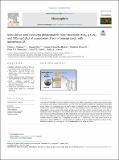Files in this item
Solar-driven semi-conductor photocatalytic water treatment (TiO2, g-C3N4, and TiO2+g-C3N4) of cyanotoxins : proof-of-concept study with microcystin-LR
Item metadata
| dc.contributor.author | Pestana, Carlos J | |
| dc.contributor.author | Hui, Jianing | |
| dc.contributor.author | Camacho-Muñoz, Dolores | |
| dc.contributor.author | Edwards, Christine | |
| dc.contributor.author | Robertson, Peter K J | |
| dc.contributor.author | Irvine, John T S | |
| dc.contributor.author | Lawton, Linda A | |
| dc.date.accessioned | 2022-11-03T12:30:27Z | |
| dc.date.available | 2022-11-03T12:30:27Z | |
| dc.date.issued | 2023-01-01 | |
| dc.identifier | 281992280 | |
| dc.identifier | ab62f424-8f7f-476b-97f1-a48e23e92f93 | |
| dc.identifier | 36241123 | |
| dc.identifier | 85139864651 | |
| dc.identifier | 000874749400004 | |
| dc.identifier.citation | Pestana , C J , Hui , J , Camacho-Muñoz , D , Edwards , C , Robertson , P K J , Irvine , J T S & Lawton , L A 2023 , ' Solar-driven semi-conductor photocatalytic water treatment (TiO 2 , g-C 3 N 4 , and TiO 2 +g-C 3 N 4 ) of cyanotoxins : proof-of-concept study with microcystin-LR ' , Chemosphere , vol. 310 , 136828 . https://doi.org/10.1016/j.chemosphere.2022.136828 | en |
| dc.identifier.issn | 1879-1298 | |
| dc.identifier.other | Jisc: 688706 | |
| dc.identifier.other | pii: S0045-6535(22)03321-5 | |
| dc.identifier.other | ORCID: /0000-0002-8394-3359/work/122215789 | |
| dc.identifier.uri | https://hdl.handle.net/10023/26296 | |
| dc.description | Funding: We acknowledge the funding provided by the Engineering and Physical Sciences Research Council, UK (Global Challenge Research Fund: EP/P029280/1) towards carrying out this research. We also thank the support on electron microscopes from EPSRC Capital for Great Technologies (Grant EP/LP017008/1 and EP/R02375/1). | en |
| dc.description.abstract | Cyanobacteria and their toxins are a threat to drinking water safety as increasingly cyanobacterial blooms (mass occurrences) occur in lakes and reservoirs all over the world. Photocatalytic removal of cyanotoxins by solar light active catalysts is a promising way to purify water at relatively low cost compared to modifying existing infrastructure. We have established a facile and low-cost method to obtain TiO2 and g-C3N4 coated floating photocatalysts using recycled glass beads. g-C3N4 coated and TiO2+g-C3N4 co-coated beads were able to completely remove microcystin-LR in artificial fresh water under both natural and simulated solar light irradiation without agitation in less than 2 h. TiO2 coated beads achieved complete removal within 8 h of irradiation. TiO2+g-C3N4 beads were more effective than g-C3N4 beads as demonstrated by the increase reaction rate with reaction constants, 0.0485 min−1 compared to 0.0264 min−1 respectively, with TiO2 alone found to be considerably slower 0.0072 min−1. g-C3N4 based photocatalysts showed a similar degradation pathway to TiO2 based photocatalysts by attacking the C6–C7 double bond on the Adda side chain. | |
| dc.format.extent | 10 | |
| dc.format.extent | 5281365 | |
| dc.language.iso | eng | |
| dc.relation.ispartof | Chemosphere | en |
| dc.subject | Water treatment | en |
| dc.subject | Visible light photocatalysis | en |
| dc.subject | Graphitic-carbon nitride | en |
| dc.subject | Titanium dioxide | en |
| dc.subject | In-reservoir treatment | en |
| dc.subject | QD Chemistry | en |
| dc.subject | NDAS | en |
| dc.subject | MCC | en |
| dc.subject.lcc | QD | en |
| dc.title | Solar-driven semi-conductor photocatalytic water treatment (TiO2, g-C3N4, and TiO2+g-C3N4) of cyanotoxins : proof-of-concept study with microcystin-LR | en |
| dc.type | Journal article | en |
| dc.contributor.sponsor | EPSRC | en |
| dc.contributor.institution | University of St Andrews. School of Chemistry | en |
| dc.contributor.institution | University of St Andrews. Centre for Energy Ethics | en |
| dc.contributor.institution | University of St Andrews. Centre for Designer Quantum Materials | en |
| dc.contributor.institution | University of St Andrews. EaSTCHEM | en |
| dc.identifier.doi | https://doi.org/10.1016/j.chemosphere.2022.136828 | |
| dc.description.status | Peer reviewed | en |
| dc.identifier.grantnumber | EP/P029280/1 | en |
This item appears in the following Collection(s)
Items in the St Andrews Research Repository are protected by copyright, with all rights reserved, unless otherwise indicated.

